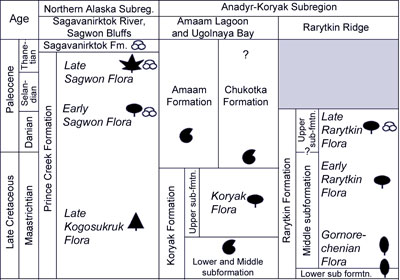Correlations
| North Pacific | AKSR-NASR | Anadyr-Koryak | Verkhoyansk-Chukotka | Okhotsk-Chukotka | N. Alaska | Yukon | Chignik |
|---|---|---|---|---|---|---|---|
| Phytostratigraphy | Images of fossils characteristic of the Type Taphoflora | ||||||
The Early Sagwon Phase of Floral EvolutionIn the Sagavanirktok River basin, Upper Cretaceous deposits of the Seabee and Schrader Bluff formations of the Colville Group are overlain and, in part, laterally substituted, by terrigenous and coal-bearing deposits of the Prince Creek Formation of the Colville Group (Late Cretaceous–Paleocene). These in turn are overlain by conglomerates and sandstones belonging to the basal Sagwon Member of the Sagavanirktok Formation, dated to the Late Paleocene–Miocene (Mull and Harris, 1989; Mull et al., 2003). The upper part of the Prince Creek Formation is best exposed in the Sagwon Bluffs section, an outcrop on the west bank of the Sagavanirktok River), and is composed of intercalating conglomerates, sandstones, siltstones, coaly shales, and coals (in total up to six or seven more or less laterally continuous seams) up to 7 m thick (Mull et al., 2003). The Early Sagwon flora is known from several localities in the lower part of the section, below coal bed no. 3 (numered from the bottom). It was previously named just the ‘Sagwon flora’ before the younger floristic assemblage was found (Spicer et al., 1994; Herman et al., 2004; Herman and Moiseeva, 2006). The Early Sagwon flora in the Sagwon Bluffs of the Sagavanirktok River is considered to be the type flora of the phase. It is dated to the Paleocene (probably Danian–Selandian) on the basis of palynological data (Frederiksen et al., 1996; Mull et al., 2003; Jolley et al., 2006; Spicer et al., 2009; Daly et al., 2011) and plant megafossils (Spicer et al., 2009; Herman, 2011a). The plant-bearing deposits exposed in the Sagwon Bluffs below coal seam no. 3 are distinguished as Beds within the Early Sagwon flora. The duration of the Early Sagwon phase is about 4 – 5 m.y. The Early Sagwon flora includes more than 30 species of fossil plants (Herman et al., 2004; Herman and Moiseeva, 2006; Spicer et al., 2009; Daly et al., 2011). Plant taxa of the flora are listed in the panel to the right. Dicotyledonous angiosperms and conifers are dominant in the flora and occur in association with rare horsetails, ferns, and monocots; ginkgoaleans are absent. Very characteristic of the Early Sagwon flora are polymorphic leaves Corylites beringianus, which attain a great size, Metasequoia occidentalis shoots, and leaflets or compound leaves and leaf rosettes of Quereuxia angulata in some assemblages. This species, along with monocots Haemanthophyllum and Phragmites, represented apparently the "aquatic community". The other characteristic forms in the flora are Equisetum arcticum, Onoclea hesperia, Mesocyparis, Fokieniopsis aff. catenulata, Haemanthophyllum ex gr. kamtschaticum, Sparganiophyllum, Phragmites, Trochodendroides, Cissites, Nyssidium, “Cocculus”, Rarytkinia, Ettingshausenia, Celastrinites, Castaliites, Liriophyllum cf. aeternum, leaf of Rosaceae affinity (cf. Rubus), and some fructifications. Structurally preserved wood is also found in some abundance but usually only as ‘float’ along the river margins. Being of not great taxonomic diversity in general, the Early Sagwon flora is, nevertheless, twice as diverse as the Late Kogosukruk flora. In addition, angiosperms representing the dominant group of plants in the Early Sagwon flora occur only as isolated specimens in the Late Kogosukruk flora. The next essential distinction between the two floras is the prevalence in the Early Sagwon flora of typical Early Cenozoic taxa, i.e., of Onoclea hesperia, Metasequoia occidentalis, Haemanthophyllum ex gr. kamtschaticum, Corylites beringianus, Viburnum rarytkense, Rarytkinia cf. terehovae, three Trochodendroides species, and maybe plants of the family Rosaceae, whereas the Late Kogosukruk flora is dominated mainly by the Late Cretaceous fossil plants and forms of a wide stratigraphic range. The Early Sagwon flora is similar to the Koryak flora from the Amaam Lagoon area of the Anadyr–Koryak Subregion. The dominant taxa of both floras are Corylites beringianus, Trochodendroides, and Metasequoia occidentalis. They also include a variety of other taxa in common: species Equisetum arcticum, Onoclea hesperia, Metasequoia, Nyssidium arcticum, Liriophyllum cf. aeternum, and genera Mesocyparis, Haemanthophyllum, Sparganiophyllum, Rarytkinia, Ettingshausenia, Celastrinites and Cissites.
|
|
|||
 |
Correlation chart showing the relationships between the Sagwon floras and those in northeastern Russia. |
|||

